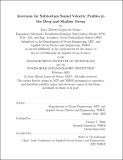| dc.contributor.advisor | George V. Frisk. | en_US |
| dc.contributor.author | Souza, Luiz Alberto Lopes de | en_US |
| dc.contributor.other | Woods Hole Oceanographic Institution. | en_US |
| dc.date.accessioned | 2007-10-19T21:05:29Z | |
| dc.date.available | 2007-10-19T21:05:29Z | |
| dc.date.copyright | 2005 | en_US |
| dc.date.issued | 2005 | en_US |
| dc.identifier.uri | http://hdl.handle.net/1721.1/39226 | |
| dc.description | Thesis (Ph. D.)--Joint Program in Applied Ocean Science and Engineering (Massachusetts Institute of Technology, Dept. of Ocean Engineering; and the Woods Hole Oceanographic Institution), 2005. | en_US |
| dc.description | This electronic version was submitted by the student author. The certified thesis is available in the Institute Archives and Special Collections. | en_US |
| dc.description | Bibliography: leaves 292-301. | en_US |
| dc.description.abstract | This thesis investigates the application of acoustic measurements in the deep and shallow ocean to infer the sound velocity profile (svp) in the seabed. For the deep water ocean, an exact method based on the Gelfand-Levitan integral equation is evaluated. The input data is the complex plane-wave refection coefficient estimated from measurements of acoustic pressure in water. We apply the method to experimental data and estimate both the refection coefficient and the seabed svp. A rigorous inversion scheme is hence applied in a realistic problem. For the shallow ocean, an inverse eigenvalue technique is developed. The input data are the eigenvalues associated with propagating modes, measured as a function of source receiver range. We investigate the estimation of eigenvalues from acoustic fields measured in laterally varying environments. We also investigate the errors associated with estimating varying modal eigenvalues, analogous to the estimation of time-varying frequencies in multicomponent signals, using time-varying autoregressive (TVAR) methods. We propose and analyze two AR sequential estimators, one for model coefficients, another for the zeros of the AR characteristic polynomial. | en_US |
| dc.description.abstract | (cont.) The decimation of the pressure field defined in a discrete range grid is analyzed as a tool to improve AR estimation. The nonlinear eigenvalue inverse problem of estimating the svp from a sequence of eigenvalues is solved by iterating linearized approximations. The solution to the inverse problem is proposed in the form of a Kalman filter. The resolution and variance of the eigenvalue inverse problem are analyzed in terms of the Cramer-Rao lower bound and the Backus{Gilbert (BG) resolution theory. BG theory is applied to the design of shallow-water experiments. A method is developed to compensate for the Doppler deviation observed in experiments with moving sources. | en_US |
| dc.description.statementofresponsibility | by Luiz Alberto Lopes de Souza. | en_US |
| dc.format.extent | 2 v. (301 leaves) | en_US |
| dc.language.iso | eng | en_US |
| dc.publisher | Massachusetts Institute of Technology | en_US |
| dc.rights | M.I.T. theses are protected by copyright. They may be viewed from this source for any purpose, but reproduction or distribution in any format is prohibited without written permission. See provided URL for inquiries about permission. | en_US |
| dc.rights.uri | http://dspace.mit.edu/handle/1721.1/7582 | |
| dc.subject | /Woods Hole Oceanographic Institution. Joint Program in Applied Ocean Science and Engineering. | en_US |
| dc.subject | Ocean Engineering. | en_US |
| dc.subject | Woods Hole Oceanographic Institution. | en_US |
| dc.subject.lcsh | Underwater acoustics Measurement | en_US |
| dc.title | Inversion for subbottom sound velocity profiles in the deep and shallow ocean | en_US |
| dc.title.alternative | Inversion for subbottom SVPs in the deep and shallow ocean | en_US |
| dc.type | Thesis | en_US |
| dc.description.degree | Ph.D. | en_US |
| dc.contributor.department | Joint Program in Applied Ocean Physics and Engineering | en_US |
| dc.contributor.department | Woods Hole Oceanographic Institution | en_US |
| dc.contributor.department | Massachusetts Institute of Technology. Department of Ocean Engineering | |
| dc.identifier.oclc | 63656392 | en_US |
